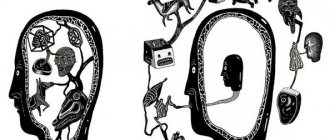The type of temperament is an innate feature of the human nervous system. Basically, it remains unchanged throughout life (not to be confused with character). Knowing the type of temperament, we can say about the speed of occurrence and intensity of an individual’s mental processes, the strength of his emotions, and these are not all the characteristics.
Each temperament has its own capabilities - find out which activity suits you
To determine your temperament type, take the test. The accuracy of the result depends on how honest you are with yourself. A brief description of each type of temperament is below the test. When two types of temperament are combined, the test does not give an interpretation, read it yourself. So let's get started...
What is temperament?
For convenience, psychologists have generalized individual mental characteristics into 4 groups. They are called temperament and predict a person's behavior in various situations. The main differences among character types are the degree of mobility, impressionability, strength and duration of experiences. They are divided into four types:
- choleric – reacts sharply to even the most insignificant events;
- sanguine – less impressionable and more balanced;
- melancholic – sensitive, has low mobility;
- phlegmatic – calm, balanced type.
The most favorable type with stable reactions is the sanguine person. Together with choleric people, they are extroverts, their attention is directed to the world around them. Melancholic and phlegmatic people are introverts, completely absorbed in their experiences. At the same time, phlegmatic people have more stable reactions in their nervous system, and the weakest among all are melancholic people.
Why know your psychotype?
When choosing a profession, mental inclinations play a decisive role. One will be delighted with boring and monotonous work, another needs eternal competition, and the third cannot live without daily communication with people.
Having incorrectly assessed the advantages and disadvantages of his psyche, a person selects an unsuitable job. Over the years, this leads to depression and professional burnout.
It is important to know the differences in temperaments when working with other people, in particular when raising children. The child’s psyche is a fragile mechanism that can easily be damaged by choosing the wrong approach. Often choleric parents put pressure on a melancholic or phlegmatic child. They reproach him for slowness, absent-mindedness, and laziness. Although in fact it simply differs from them in less mobility. The same thing works in relationships between boss and subordinate, teacher and student, and between sexual partners.
Basic knowledge of the differences between different types of characters will help you establish contacts with your environment, achieve your goals more often, and find a job you like.
Why are emotions needed?
Sometimes they say: “emotions are needed to make life brighter.” People whose lives turned out to be too “bright” dream of having no emotions at all: “it’s better to be a robot who doesn’t feel anything.” In fact, emotions are not a bonus or a special effect. Like any mental process, they perform an important function and help us adapt to the external environment.
What is an emotion? In simple terms, this is how we evaluate what is happening. We see a mad dog - we feel fear; We discover that the other person did not live up to our expectations - we feel disappointed or offended. Emotions help us stay in touch with reality and adapt to it. This is a psychic signal, an internal indicator. Information that helps us survive.
How long can a person who is not afraid of anything live? How adequately will someone who does not feel shame behave? How to protect yourself from poisoning if you don’t feel disgust? Emotions are a means of adaptation to the environment. An evolutionarily developed mechanism that helps us become stronger, more efficient, more viable. So why are we fighting them?
Emotions can be difficult and painful. It is at such moments that you want to turn them off, turn down the brightness, turn down the volume. Suffering from mental pain is sometimes felt as acutely as suffering from a physical illness.
But what is pain? This is a signal of maladjustment. It hurts to bang your head against the wall, it hurts to hold your hand on fire, it hurts when they cut us with a knife. Emotional pain, like physical pain, communicates that we are doing something wrong, that we are in danger, that our self or our body is under threat. And pushes to eliminate the danger. Is it wise to fight this signal?
There are no good and bad emotions. Fear, sadness, resentment, anger, envy are not bad emotions! These are mental signals that we are not adapted in some way. Somewhere weak. Instead of fighting this signal, you need to listen to it. See emotions, recognize them, study them - and help fulfill their function.
Every emotion can be functional or dysfunctional. Functional emotion fades away on its own. I met a bear in the forest - I got scared - I walked around - the fear disappeared. If we get “stuck” in an emotion, replay the situation over and over again, cannot forgive the offender, cannot relieve anxiety, are unable to get rid of the feeling of guilt, then the emotion has not fulfilled its function. That's why he comes again and again! This is a flashing light, a blaring siren, indicating that fuel is leaking from the gas tank, and the plane is rushing towards the ground like a stone. The longer we ignore this signal, the louder it sounds. So that we can finally hear him and react! Turned a dysfunctional emotion into a functional one. Useless - into useful.
Basic functions of emotions. The first is evaluative: emotions help us evaluate and reevaluate reality. Adjust your picture of the world. For example, if I resent a friend for not doing something, the resentment will dissipate when I stop making false expectations about his behavior. After all, my forecast did not come true; my ideas are at odds with the facts. Resentment is a signal of a discrepancy between the expected and the actual. The function of resentment will be fulfilled when my ideas about the other begin to correspond to reality.
Another function is regulatory. Emotion pushes us to change our own behavior. In case of fear - avoid danger, anger - remove an obstacle, resentment - achieve what you want on your own. The emotion says: we're in trouble, do something about it. And if we respond properly to this signal, the emotion fades away.
The third function is communicative. Sometimes we need to tell others how we feel: with facial expressions, actions, words. Let your partner know that his actions scare us; talk about the grievance; show embarrassment; admit guilt. Emotions help us connect with others and encourage others to change their behavior.
When one or more functions are completed, the intensity of the emotion gradually decreases. Resentment is replaced by slight disappointment, shame by regret, envy by respect. Without any struggle, naturally. The Moor has done his job, the Moor can leave.
This is what is called emotional intelligence or emotional competence: the ability to recognize your feelings, listen to them and respond appropriately.
Make friends with your emotions to become stronger and happier.
How to find out your temperament and is it possible to change it?
There are 2 classic tests for determining temperament: Eysenck and Belov. You can take these tests online using the following links: Eysenck test and Belov test. The first test has 45 questions, the second – 85. The determination method in both tests is simple: a person is given a certain number of statements, each of which falls under the definition of 4 types of personalities. The only answer options are “yes” or “no”. Like other tests, this determination method is not 100% reliable. A person can embellish answers by choosing the most appropriate answer options in his opinion.
Temperaments in their pure form are quite rare. Most people combine 2 or even 3 types. Sanguine + choleric is the most common combined type. There are also such interesting combinations as sanguine + phlegmatic or melancholic + choleric.
Is it possible to change the type of temperament?
The main difference between temperament and character or bad habits is that it is determined before a person is born. It is impossible to completely change it, but it can be trained: suppress anger or attacks of melancholy, apathy. In other words, learn to live in harmony with yourself.
Character traits are formed not only due to temperament, but also due to sociocultural characteristics of development. The external environment in which a person grew up. If from childhood a choleric person was taught that he needs to be polite and restrained, he won’t hurt a fly in public. But give him the will and authority, his temperament will manifest itself. Also with sanguine and melancholic people. If their behavior was socially unacceptable, it was suppressed by developing the correct character traits.
It is possible and necessary to strengthen your character, so you should not blame your temperament for irritability or tearfulness.
Which famous people were phlegmatic?
Among the famous people, “pure” phlegmatic people were Galileo Galilei, Antonie van Leeuwenhoek (inventor of the microscope), Academician Lyubishchev, Karl Baer (founder of embryology), Emmanuel Kant. Among the famous people who were choleric were Salvador Dali, Peter the Great, and Vasily Chapaev.
Interesting materials:
Who won the car from Hussein? Who won a billion in the Russian Lotto lottery? Who issues a written undertaking not to leave? Who makes the decision? Who left Black Star? Who captured Carthage? Who captured Rome? Who develops job descriptions at the enterprise? Who is Dobronravov's wife? Who lived in Jerusalem?
How to determine the temperament of a woman or man by appearance
The type of temperament is often clearly characterized by external signs. So, for example, a caricatured melancholic is thin, tall, with an elongated and sad face.
This is how the famous artist H. Bidstrup described the external features of the various types:
More details about each type:
- Sanguine people have round shapes and may be overweight. Medium or short height. The gait is relaxed, swaggering. The face is round or heart-shaped, the nose is most often bulbous or slightly upturned. Cheekbones are not pronounced.
- Phlegmatic people are slow, recognized by their measured, unhurried gait. Although they have a strong physique, they are also prone to obesity. The body is firmly built, barrel-shaped, tall. Facial features rarely have sharp and memorable shapes.
- Cholerics are easy to recognize: they are thin people with pointed facial features. Their movements are energetic and fast. The nose is clearly defined, often with a hump.
- Melancholic people are pale, thin, and have a sickly appearance. The lips are thin, the corners of the mouth are downturned, which gives the face an expression of deep sadness.
Don't make hasty conclusions based on a person's appearance: it can often be deceiving. Only a psychologist can accurately determine a person’s temperament.
Sanguines
Sanguine people are energetic and friendly, welcoming and sociable; with any person they will always have a topic to talk about. They say about such people: “They don’t mince words.”
Any event that attracts the attention of a sanguine person evokes a lively response from him: he either laughs at the slightest reason or just as sincerely gets angry for some insignificant reason. The facial expressions and gestures of a sanguine person are bright and expressive - from them you can easily determine his mood. But if he wants, he can completely control his feelings and not show them.
Sanguine people are optimists, they are carefree and joyful, they live in the present, do not remember past failures and do not think about the future. They are active and efficient, they are alien to routine and monotony, they crave new bright impressions.
But sanguine people are often fickle, disorganized and have a tendency to use other people, make promises and not keep them. They easily admit their guilt and just as easily find excuses for themselves and ask for forgiveness, but they continue to behave as before. They can be on their own and impose their point of view; they like to dominate.
Martin Seligman: Well-being and “learned optimism”
At the WBECS (The World's Leading Learning Platform) conference
For Business & Executive Coaches) there was a discussion with Martin Seligman, a famous American psychologist, one of the founders of positive psychology.
Martin Seligman has spent decades studying how people cope with adversity and found that the things that most hinder recovery from traumatic events are the so-called three Ps:
- personalization - the belief that we ourselves are to blame;
- ubiquity - the belief that an event will affect all areas of our lives, and
- permanence - the belief that the consequences of an event will always be felt.
People recover faster if they understand that what happened is not their fault, that it cannot affect every aspect of their life and will not haunt them everywhere and always.
Awareness of this reduces the likelihood of depression and helps you overcome difficulties.
I read about learned helplessness in a book by Martin Seligman. And now, during the Covid-19 pandemic, this is one of the challenges - to relearn and crawl out of this acquired helplessness.
From a state in which people stop trying to improve it because they have failed several times.
Martin Seligman first began studying the topic of learned helplessness in 1967.
Martin Seligman said that one of the benefits of working in science for 50 years is the ability to discover that you were wrong.
We were wrong—helplessness is the default state of mammals.
We are born and grow up with this helplessness.
And what we can learn is learned optimism.
We can learn:
- Perceive failures as something temporary rather than permanent (“it’s a hard time now, but it will get better later” instead of “I’ll never be happy again”)
Perceive failures as an isolated incident, rather than a personal characteristic (“I didn’t succeed this time” instead of “I’m a failure”)
- Become aware of what we can control and what we can influence.
And for me this is good news. If there is a feeling of helplessness, then we should start learning to be optimistic and this is something we can control.
Martin talked a lot about happiness, talked about the idea of conscious optimism, and how this affects well-being.
One of the main differences between pessimistic people and optimistic people is that the former believe that problems are permanent, while the latter believe that problems are temporary. For example, the former believe that “the situation cannot be corrected,” and the latter believe that “the situation cannot be corrected if nothing is done.”
That is, the bad thing is not that it’s bad, but that it continues and is sustainable. Resilience can also manifest itself in endowing people with various qualities. Compare, for example, “my boss is an asshole” (pessimistic) and “my boss is in a bad mood today” (more optimistic) - in this example, troubles are perceived as a temporary phenomenon.
Universality adds pessimism, specificity adds optimism. The attitude “I can’t handle anything” leaves no choice, while “I can’t handle THIS job” suggests that there is a possible solution. As they say, realistic argument vs catastrophic thought (sober view versus panicky thoughts)
I think you understand that life in general is simpler for those who are optimistic. And at work they achieve better results (there is, however, one exception here - lawyers - it is pessimism that allows them to work effectively, according to Martin), and with health, and on a personal level, everything is somehow better.
Martin Seligman coins the term “learned optimism,” as if to imply that it can be learned.
Indeed, we are able to influence our thinking, and through it, our behavior and vice versa.
Melancholic
Pessimistic people are often called melancholic. And for good reason. It is they, according to psychologists, who are more susceptible to depression than other types. They do not need to look for reasons to be sad, since self-pity already sets a person up for a negative wave. To better understand a melancholic person, it is necessary to study the description of his temperament:
- He does not like screams or harsh sounds, so in his company it is necessary to behave with restraint.
- Criticism deeply hurts his tender nature. If it is necessary to give a negative assessment of his actions, then it is better to express censure in a mild form.
- Entertainment related to extreme sports is not for him.
- Loves intimate conversations with sincere and sad stories.
- Prone to drama.
- Prefers work that requires concentration and attention. But he hates being pushed, because he immediately gets lost and panics.
- He makes new acquaintances slowly, preferring to first take a closer look at possible friends.
- He has developed intuition, which rarely lets him down.
Due to indecision and fear of rejection, melancholic people cannot build relationships for a long time. But as partners they choose individuals who are distinguished by temperament, will and perseverance, that is, those qualities that they themselves lack.
READ How to increase self-esteem: identifying and eliminating the causes of self-doubt
Strengths
Using his positive qualities to the fullest, a melancholic person is able to reach the pinnacle of success in his chosen field and make discoveries. Its strengths include:
- Giftedness, a penchant for creativity. He shows himself quite well in acting and music.
- Integrity and dedication.
- Ability for philosophical reasoning.
- Sensitivity. He is especially sensitive to beauty.
- Thoughtfulness and prudence. Possesses analytical thinking and is able to think deeply.
The melancholic person is devoted to his family and friends and always tries to keep his promises. He is independent, preferring not to react to rewards and possible punishments. Looks at the world realistically and assesses his capabilities without illusions.
Flaws
The basis of the shortcomings is the tendency to low self-esteem. A melancholic person constantly looks for flaws in himself, which prevents him from enjoying life. The disadvantages of temperament include:
- Good memory for negative life events.
- Concentrates on himself and his own experiences.
- Predisposed to hypochondria and persecution mania, developing a mental dependence on negative emotions.
- He is characterized by isolation, vulnerability, and is subject to frequent mood swings.
- He likes to have his head in the clouds, so he often ignores conversations.
Melancholic children and teenagers are especially vulnerable. Parents should develop a concept for raising a child in order to raise a confident, successful person and suppress an unreasonable inferiority complex in him.
Wise advice from a mathematician
I will remember this incident for the rest of my life. We had a test in mathematics, and the teacher, let’s call her V.N., combined teaching with some other administrative position. It so happened that because of this combination, she had to take the test in some kind of cramped closet that could accommodate 4 people plus herself. So I walk in with a notebook and start mumbling something, some kind of excuse or explanation, I don’t remember exactly now, but something insignificant. To which she tells me:
“Listen, why are you bothering me with this now, this has nothing to do with the matter at all, hand over your notebook and go.” really have to keep so many things in my head
The important thing is that I won’t even listen to your info noise, sorry, all the shelves in my head are already occupied.










